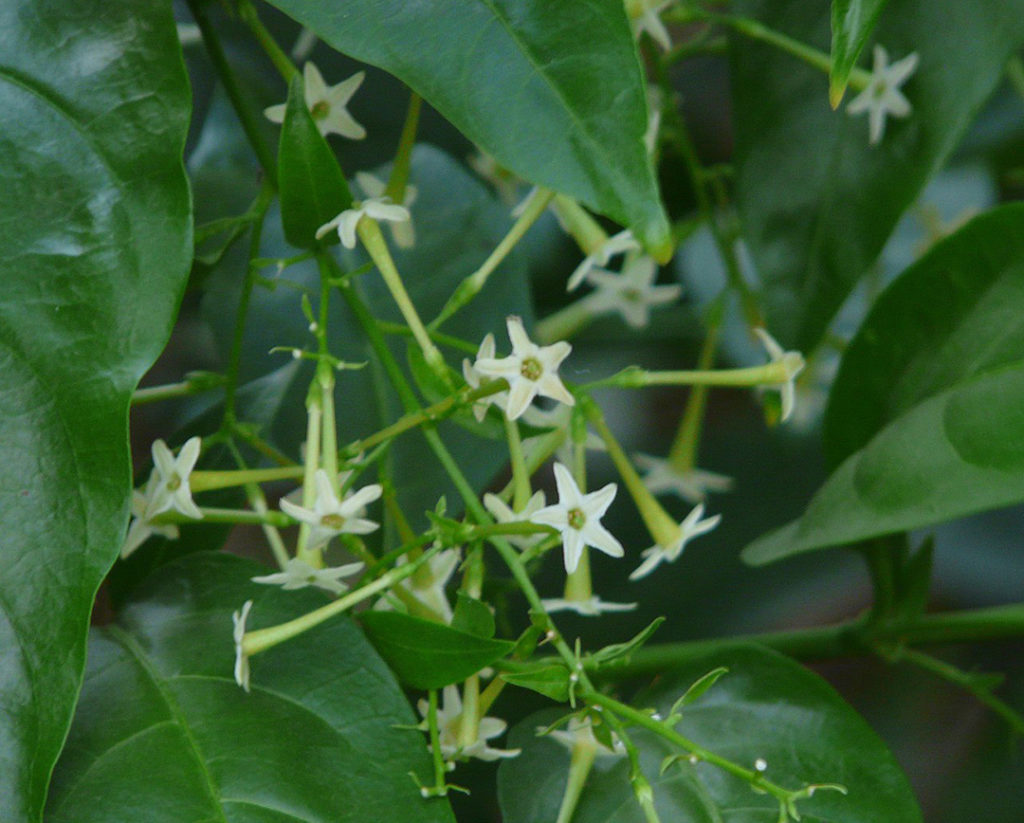
Barbados
Night-Blooming Jasmine
Cestrum nocturnum

General Description / Cultural Significance
Night-Blooming Jasmine, Cestrum nocturnum, also called “Lady of the Night” in Barbados, produces large clusters of night-blooming, highly fragrant flowers. As a member of the nightshade family, the plant also produces berries that are toxic to humans and most animals if eaten. Lady of the Night likes well-drained, sandy soil and partial to full sun. It also tolerates high temperatures, to a point. The plant has a temperature threshold and once that point is passed the quality of the scent changes as does the duration and number of flowers.
Climate Change/Conservation Status
The small islands of Barbados are comprised primarily of porous limestone and the water is vulnerable to pollution contamination. Although Barbados opened a large desalination facility in 2000, water scarcity is still an issue because of the change in precipitation patterns and the rising sea level which causes saltwater intrusion. The Barbados government has promoted rainwater storage to increase the availability of freshwater. However, health officers have reported that mosquito breeding in the rainwater storage tanks might be the reason for Barbados’ having the highest rate of dengue fever in the Americas.
The agricultural areas of the island have been plagued by stronger storms and hurricanes with increased frequency. The hurricanes of 2017 destroyed almost all of the crops on the island and cause soil erosion in addition to landslides.
The majority of the coral in the Caribbean has bleached due to increased ocean temperatures and researchers have documented evidence that tropical fish such as the parrot, snapper and grouper are migrating towards the poles. Both coral reefs and mangroves which surround the islands are imperative to the region’s early fish life. Rising ocean temperatures and ocean acidification due to carbon dioxide absorption along with saltwater infiltration are damaging these mangroves where young aquatic life is nurtured. It is thought that a 1.5°C (34.70ºF) warming point will be reached by 2030 at which point up to ninety percent of the coral reefs would be gone.
Alternate Names
Lady of the Night
Night Jasmine
Night Jessamine
Night-Blooming Jessamine
Queen of the Night
Sources
Climate Links, 2018. Climate Risk Profile: Eastern and Southern Caribbean. US Agency of International Development. [website]
Erowid, 2008. Cestrum nocturnum Health Concerns. Erowid. [website]
Forde, S., 2018. Climate Change Warning for Small Island States. Relief Web. [website]
Global Invasive Species Database, 2010. Ecology of Cestrum nocturnum. ISSG Database of IUCN SSC. [website]
Handler, J., & Jacoby, J., 1993. Slave Medicine and Plant Use in Barbados. Journal of the Barbados Museum and Historical Society, 41. [website]
Jackson, C., Phillips, A.D.V., & Marshall, W., 2022. Barbados – Climate. Encyclopedia Britannica. [website]
Operations Manager, Flower Forest of Barbados Limited, St. Joseph, Barbados, West Indies and The Barbados Office of the Barbados Tourism Authority, Bridgetown, Barbados. This statement can be found on the World Sensorium original website.
Praveen, D., & Ramachandran A., 2017. Development of regional crop simulation modeling for jasmine under the purview of climate change: a perspective from Tamil Nadu, India. Horticult Int J., 1(2): pp. 49-51. DOI: 10.15406/hij.2017.01.00009.
Punjabi, Y., Khilnani, V., & Damle, P., 2015. The Investigation of Antibacterial Activity of Cestrum nocturnum. Pharmacophore, [website] 6(2): pp. 81-87
World Health Organization, 2019. Climate change adaptation to protect human health: Barbados. World Health Organization. [website]

